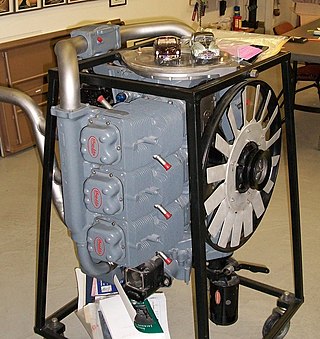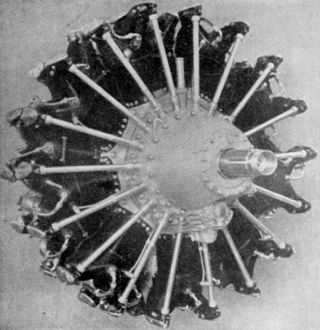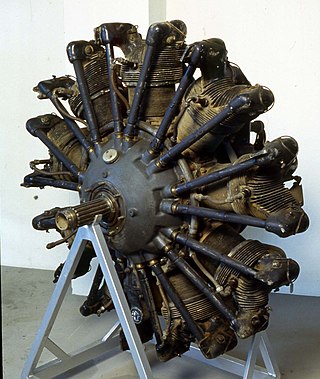
The Piaggio P.XI was an Italian 14-cylinder radial aircraft engine. The P.XI was a licensed derivative of the French Gnome-Rhône Mistral Major 14K produced in Italy.

The Armstrong Siddeley Lynx is a British seven-cylinder aero engine developed by Armstrong Siddeley. It was developed as a single row version of the two-row Armstrong Siddeley Jaguar. Testing began in 1920 and 6,000 had been produced by 1939. In Italy Alfa Romeo built a 200 horsepower (150 kW) licensed version of this engine named the Alfa Romeo Lynx.

The Franklin O-335 was an American air-cooled aircraft engine of the 1940s. The engine was of six-cylinder, horizontally-opposed layout and displaced 335 cu in (5.5 L). The power output of later variants was 225 hp (168 kW).

The Fiat A.80 was an 18-cylinder, twin-row, air-cooled, radial aircraft engine produced during World War II. Rated at 750 kW (1,000 hp), it was a more powerful development of the 14-cylinder Fiat A.74.
The Agusta GA.140/V is a 4-cylinder, air-cooled, horizontally opposed engine mounted vertically, developed in Italy for helicopter use and produced from 1962 to 1969.

The Alfa Romeo 115 is an Italian six-cylinder air-cooled inverted inline engine for aircraft use, mainly for training and light planes, based on the de Havilland Gipsy Six engine. Production totalled approximately 1,600 units. Derivatives of the 115 include the -1, bis, ter and Alfa Romeo 116.

The Fiat A.54 was a seven-cylinder, air-cooled radial engine developed in Italy in the 1930s as a powerplant for aircraft. Amongst others, it powered the Ambrosini SAI.1 and SAI.2 racing aircraft.

The Alfa Romeo D2 was a nine-cylinder radial engine for aircraft use produced in Italy. It was typically rated between 240 and 270 hp. The engine was designed by Vittorio Jano, 600 units were produced between 1931 and 1934. This engine was also the first purpose-built aircraft engine produced by Alfa Romeo, previous Alfa engines used in aircraft were derived from engines used in cars. A supercharged derivative was produced as the D2 C.30.

The Alfa Romeo 135 Tornado was an Italian 18-cylinder radial engine designed by Giustino Cattaneo in 1934–1935.

The Walter Scolar was a Czechoslovakian nine-cylinder, air-cooled radial engine for powering light aircraft that first ran in 1936. With a displacement of 8 litres, it produced 132 kW at 2,500 rpm.

The Walter Castor was a Czechoslovakian seven-cylinder, air-cooled radial engine for powering aircraft that was developed in the late 1920s. The Super Castor was a nine-cylinder development. Castor I production began in 1928, Castor II in 1932 and the Castor III in 1934.

The Asso XI was a family of water-cooled, supercharged V12 piston aeroengines produced in the 1930s by Italian manufacturer Isotta Fraschini, and fitted on a number of aircraft types built by CANT, Caproni and others.
The Renault 4P, also called the Renault Bengali Junior, was a series of air-cooled 4-cylinder inverted inline aero engines designed and built in France from 1927, which produced from 95 hp (71 kW) to 150 hp (110 kW).

The SNECMA 14R was a 14-cylinder two-row air-cooled radial engine developed in France just prior to the start of World War II from the Gnome-Rhône 14N. The 14N radial engine was itself an improved version of the popular pre-war Gnome-Rhône 14K Mistral Major series; designed and manufactured by Gnome et Rhône, a major French aircraft engine manufacturer whose origins pre-date the First World War.

The Walter Sagitta was a Czechoslovakian, air-cooled, inverted V-12 engine that first ran in 1937. This was one of several smaller, low-mass medium power pre-war V-12 engines produced. With a displacement of 18.4 liters, it produced up to 373 kW at 2,500 rpm.

The Fiat AN.1 was an experimental Italian water-cooled diesel straight six cylinder aircraft engine from the late 1920s.

The Walter Junior was a family of four cylinder air cooled inverted inline engines produced by Walter Aircraft Engines in Czechoslovakia in the 1930s for aircraft, characterised by a bore and stroke of 115 mm × 140 mm, a displacement of 5,814 cm3 (354.8 cu in) and producing roughly 78 kW (105 hp).

The Walter Mars I was a nine-cylinder, air-cooled, radial engine for aircraft use built in Czechoslovakia in the late 1920s.
The Cors-Air M25Y Black Devil is an Italian aircraft engine, designed and produced by Cors-Air of Barco di Bibbiano for use in powered parachutes and very small ultralight trikes flown by heavy pilots.

The Walter Atlas was a nine-cylinder, air-cooled, radial engine for aircraft use built in Czechoslovakia in the early 1930s.

















